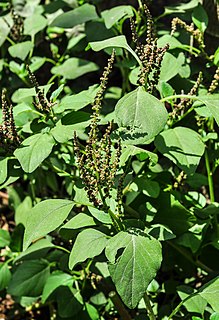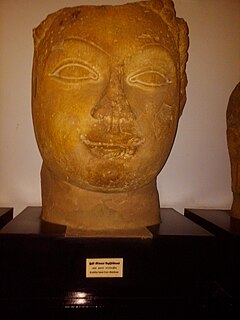
This article is about the demographic features of the population of Maldives, including population density, ethnicity, education level, health of the populace, economic status, religious affiliations and other aspects of the population.

Malé is the capital and most populous city of the Maldives. With a population of 252,768 and an area of 8.30 square kilometres (3.20 sq mi), it is also one of the most densely populated cities in the world. The city is geographically located at the southern edge of North Malé Atoll. Administratively, the city consists of a central island, an airport island, and four other islands governed by the Malé City Council.

Bidens is a genus of flowering plants in the aster family, Asteraceae. The common names beggarticks, black jack, burr marigolds, cobbler's pegs, Spanish needles, stickseeds, tickseeds and tickseed sunflowers refer to the fruits of the plants, most of which are bristly and barbed, with two sharp pappi at the end. The generic name refers to the same character; Bidens comes from the Latin bis ("two") and dens ("tooth").

Conyza is a genus of flowering plants in the family Asteraceae.

The culture of the Maldives is derived from a number of sources, the most important of which is its proximity to the shores of Sri Lanka and South India. The population is mainly Indo-Aryan from the anthropological point of view.

Amaranthus viridis is a cosmopolitan species in the botanical family Amaranthaceae and is commonly known as slender amaranth or green amaranth.

Hinduism in the Maldives describes the practice of the Hindu religion in the Maldives archipelago. Hinduism generally fits between the earlier Vajrayana Buddhism and the subsequent transition to Islam. Archaeological remains survive from the 8th or 9th century CE portraying Hindu deities such as Shiva, Lakshmi and the sage Agastya.
Maldivian mythology or Maldivian folklore is the body of myths, tales and anecdotes belonging to the oral tradition of Maldivians. Even though some of the Maldivian myths were already mentioned briefly by British commissioner in Ceylon HCP Bell towards the end of the 19th century, their study and publication were carried out only quite recently by Spanish writer and artist Xavier Romero-Frias, at a time when that ancestral worldview was quickly disappearing.

Maldives fish is cured tuna fish traditionally produced in Maldives. It is a staple of the Maldivian cuisine, Sri Lankan cuisine, as well as the cuisine of the Southern Indian states and territories of Lakshadweep, Kerala and Tamil Nadu, and in the past it was one of the main exports from Maldives to Sri Lanka, where it is known as masikaruvaduumbalakaḍa (උම්බලකඩ).

Maldivian cuisine, also called Dhivehi cuisine, is the cuisine of the Nation of Maldives and of Minicoy, India. The traditional cuisine of Maldivians is based on three main items and their derivatives: coconuts, fish and starches.

Buddhism was the predominant religion in the Maldives until at least the 12th century CE. It is not clear how and when Buddhism was introduced into the islands.

Maldivians are an Indo-Aryan ethnic group and nation native to the historic region of the Maldive Islands comprising what is now the Republic of Maldives and the island of Minicoy in Union Territory of Lakshadweep, India. All Maldivians share the same culture and speak the Maldivian language which is a member of the southern group of Indo-Aryan languages. For ethnographic and linguistic purposes as well as geo-political reasons, anthropologists divide the Maldivian people into 3 subgroups.

Xavier Romero Frías is a Spanish writer and scholar. He lived among the Maldivians over a 13-year period. His present residence is in Bangkok, Thailand.

Maldivian, also known by its endonym Dhivehi or Divehi, is an Indo-Aryan language spoken in the South Asian island country of Maldives and on Minicoy Island, Lakshadweep, union territory of India.

Senna occidentalis is a pantropical plant species.

Mas huni is a typical Maldivian breakfast, comprises tuna, onion, coconut, and chili. All ingredients are finely chopped and mixed with the grated meat of the coconut. This dish is usually eaten with freshly baked roshi flatbread and sweetened hot tea.

Sonneratia caseolaris, commonly known as mangrove apple, is a species of plant in the family Lythraceae. The fruit is noted for its outward similarity to the persimmon fruit.

Gulha is a typical and popular Maldivian short eat.
Amal Amin is an Egyptian botanist.

















